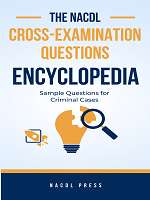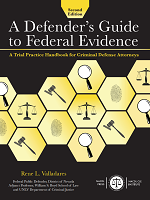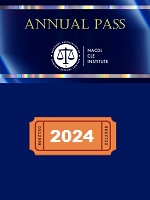Access to The Champion archive is one of many exclusive member benefits. It’s normally restricted to just NACDL members. However, this content, and others like it, is available to everyone in order to educate the public on why criminal justice reform is a necessity.
Criminal cases have always dominated the news. Read any newspaper — if you can find one — and you will see that nearly 50 percent of the front page relates to a criminal case or a criminal law issue.
But today, criminal law has a new focus: law through the lens of a camera, a new information delivery system. While there is the ever-popular traditional camcorder, surveillance security cameras and even the helicopter news driven sky-cam, it is the ubiquitous smartphone, which is every amateur investigator’s dream come true, that has captured the attention of the country and made its presence indelibly known. Cameras provide an opportunity to capture a citizen’s account of the now all-too-common images suggesting, if not establishing, oppressive and excessive law enforcement activities. They capture everything, from impolite behavior to evidence of serious criminal offenses. Without training, skill or experience, anyone can capture video footage that plays on the national news like an award-winning, scripted prime time television drama. Excessive force, police abuse, and bad behavior inconsistent with the duty to “protect and serve” can now be revealed in living color. Once a lie away from recreating history, the citizen smartphone video now packs the potency of a surreptitiously shot governmental undercover sting operation — without the possible blemish of inducement or choreography.
Police violence has been discussed in the news a lot since the August 2014 killing of Michael Brown in Ferguson, Mo. Following Ferguson, we vividly recall the citizen smartphone videos that captured police incidents on Staten Island, N.Y., and in Charleston, S.C., and Baltimore, Md. Police violence is a big problem, and the police body-worn camera is a suggested remedial response garnering a lot of attention. Perhaps more than any other piece of demonstrative evidence, it is the content of the citizen’s smartphone that has driven the discussion of police violence and the need for solutions — including the police body-worn camera.
I have directed the formation of an NACDL task force to study police body cameras and their related issues.1 The issues are legion. It is important to note that body-worn cameras and dashboard cameras are not the same. Body cameras — because officers are wearing them — by definition can only capture the actions of others (including other officers). A dashboard camera captures an officer’s actions.
Should police officers wear body cameras? What effect will cameras have on policy, the public, and policing?
If police officers know that cameras are rolling, perhaps the force they employ when making an arrest will be necessary force rather than excessive force. For members of the public alleging abuse at the hands of the police, having video footage may bolster their claims.
Questions concerning privacy abound, however, and answers are in short supply. When police departments invest in body-worn cameras, the public and the media will seek access to video footage. How does one balance and address the public’s interest in seeing the footage, a target or criminal defendant’s right to access, and a subject or crime victim’s interest in maintaining privacy? A body-worn camera will give an officer the ability to record video footage when the officer steps inside a person’s home. Will that footage be subject to disclosure under a state’s freedom of information statutes?
Should a police officer record all interactions with the public or should the decision to record be left to the officer’s discretion? Is the camera running “24/7,” and if not, at what precise time should it be engaged? Should the police capture noise complaints, arguments between neighbors, and friendly interactions with the public? On one hand, it is clear that recording everything would protect officers from unfounded complaints as well as provide evidence when a member of the public asserts a legitimate claim. When officers question eyewitnesses or alleged crime victims, should the camera be operating? Will notice be given to the person who is being recorded?
Other questions remain.
After officers make a recording, how will the data be stored? Who will have access to the data? How long will the police retain the camera footage?
Who will review the video? This question is most critical in “use of force” incidents. Will officers be allowed to examine what they recorded before they write their reports or before someone interviews them about an incident? Reviewing the video ahead of time may make officers re-examine their perspective concerning what happened, i.e., they may change their statements based on what they see on the video.
Let’s talk about cost. Who is going to pay for this? Some municipalities have shrinking coffers. They must consider the cost of purchasing the cameras, but note that the federal government has set aside money through grant programs that departments can use to purchase cameras. Specifically, on May 1, 2015, the Bureau of Justice Assistance released a grant solicitation that will provide fiscal support to help law enforcement agencies develop, implement, and evaluate body-worn camera programs. Police departments will have to bear other costs, including the costs of storing the data, maintaining and repairing the equipment, and hiring staff to handle requests from litigants and the media.
States are already tackling some of the tough questions that will arise. For example, a North Dakota law enacted in April 2015 exempts from open records requirements any image taken by police officers or firefighters in a private place with a body camera.2
What will happen when technology improves and the cameras can do more? Will there be live streaming of police interactions with the general public? What are the implications for capturing biometric information and employing facial recognition technology and iris scans?
I look forward to seeing the task force’s work in this important area. It is critical that the rights of individuals are protected. If a police department uses body-worn cameras, parameters also must be established.
NACDL, Amen!
Notes
- Professor Steven R. Morrison (Grand Forks, N.D.) is chair of the NACDL Body Camera Task Force, and NACDL Senior Privacy and National Security Counsel Jumana Musa provides staff support. Other task force members include Anna M. Durbin (Ardmore, Pa.); Kobie Flowers (Washington, D.C.); Elizabeth Kelley (Spokane, Wash.); Michael J. Nichols (East Lansing, Mich.); and Barry G. Porter (Albuquerque, N.M.).
- Signed into law on April 16, 2015, a new subsection to Section 44-04-18.7 of the North Dakota Century Code was created: An image taken by a law enforcement officer or a firefighter with a body camera or similar device and which is taken in a private place is an exempt record.
Theodore “Ted” Simon is an attorney in private practice in Philadelphia, Pa., where he has based a local, national, state, federal, and international trial and appellate practice representing individuals and corporations. Simon has obtained reversals in the U.S. Supreme Court and in the Pennsylvania Supreme Court. He is a leading authority on the representation of Americans abroad, extradition, and international prisoner transfer. Simon is a Trustee of the Foundation for Criminal Justice. He is also a member of the Board of Directors of Philadelphia’s Jenkins Law Library, America’s first law library.
Theodore Simon
Law Offices of Theodore Simon
1600 Market Street, 14th Floor
Philadelphia, PA 19103
215-563-5550
Fax 215-563-8798
Email: TSimonEsq1@aol.com







